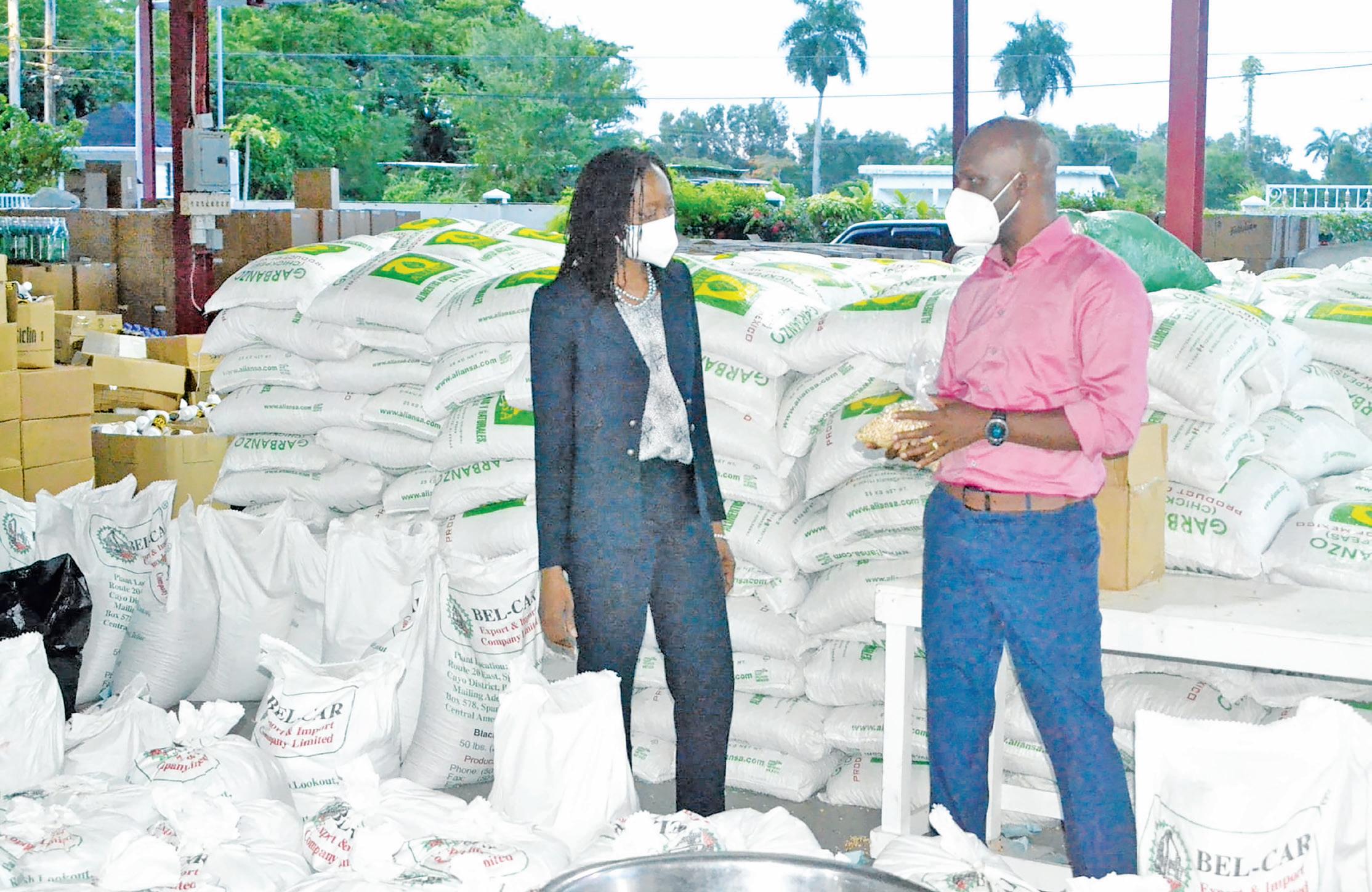
8 minute read
after Region man dies
Views
Editor: Tusika Martin News Hotline: 231-8063 Editorial: 231-0544, 223-7230, 223-7231, 225-7761 Marketing: 231-8064 Accounts: 225-6707 Mailing address: Queens Atlantic Investment Estate Industrial Site, Ruimveldt, Georgetown Email: news@guyanatimesgy.com, marketing@guyanatimesgy.com Georgetown
Parking areas in downtown Georgetown that were specially prepared by the Police Traffic Department and designated for parking by minibuses plying various routes have been overrun by vendors plying their trade and private cars working as taxis, which, as a consequence, have created chaos and congestion in central areas in the city, as well as piles of garbage accumulated over time.
The garbage accumulation continues unabated, growing from little hillocks into mountainous piles of refuse, with no solution in sight. This appears to have started in 2014 as a deliberate attempt to derail the then People’s Progressive Party/Civic (PPP/C) Government’s “Clean Up My Country” initiative.
Now, with insufficient space because of constrained parking allotments to park the buses for which the various areas were designated, bus drivers are forced to occupy areas not allotted for parking purposes, thereby creating traffic hazards and danger to pedestrians, as well as incurring the wrath of the Traffic Police.
Former Mayors Hamilton Green and Patricia Chase Green and City Councillors have, over decades, encouraged the lawlessness prevailing all over the city and its environs. Visitors come to this country to, among other things, enjoy our heritage sites, and a heap of garbage has accumulated just outside one of Guyana’s primary sight-seeing locations, specially promoted by the Tourism Ministry and tour operators – Stabroek Market.
This development is not only a public nuisance, but also constitutes a serious public health threat, with the attendant hazard of escalation of vector-borne and other serious diseases.
While the City Council condemns the business houses that are lax in paying their taxes, it simultaneously inhibits their businesses by allowing illegal vending outside the stores. This creates unfair competition, especially during special holidays and is wreaking havoc on the viability of legitimately-established businesses, because most vendors do not pay taxes, they have no overheads, are not subject to the various by-laws governing established trade, and worst of all, many create humongous garbage piles and litter that jam the waterways, with the consequence being an exacerbation in drainage problems in the city and its environs.
Georgetown has always fallen under the jurisdiction of the People’s National Congress (PNC), and from being the pride of Guyana as “The Garden City,” it has increasingly deteriorated, losing its pristine and idyllic environment. Because it has become a microcosm of the decay of Guyana under the PNC’s watch.
Political leaders have a duty and responsibility to encourage citizens to respect the laws of the land in the interest of their constituency, in particular, and the nation as a whole; and illegal vending breaches the city’s by-laws in a multiplicity of ways.
However, every time there is a governmental effort to find alternative accommodation for vendors, there is a hue and cry by political protagonists, who organise protests.
Successive PPP/C Governments intermittently pump millions of dollars into clean-up campaigns in the city, but as long as illegal vending prevails, Georgetown would always remain a “garbage city”.
Oftentimes Government executes essential capital works that are the direct responsibility of the M&CC and that body in turn castigates the Government for not giving it the money allotted for that purpose. However, the corruption at City Hall seems to have become endemic, as was revealed by the Burrowes Commission of Inquiry.
Georgetown was once a pristine and extremely scenic city, legendary for its idyllic beauty. However, under successive PNC-run City Councils, the deterioration continues to escalate, to the point where it would be a Herculean task, and necessitate the injection of massive amounts of funding, with extremely wise, creative and honest management to restore Guyana’s capital city to its former glory.

Executive Director of the Caribbean Disaster Emergency Management Agency (CDEMA), Elizabeth Riley toured the Civil Defence Commission’s storage bonds at the National Gymnasium and the Central Islamic Organisation of Guyana on Wednesday afternoon.
The tour of the bonds was facilitated by Director General of the CDC, Lieutenant Colonel Kester Craig (CDC photo)
Canada is a warning: more and more of the world will soon be too hot for humans
…without an immediate global effort to combat the climate emergency, the Earth’s uninhabitable areas will keep growing
By Simon LewiS
The climate crisis means that summer is a time of increasingly dangerous heat. This week in the Pacific north-west, temperature records are not just being broken, they are being obliterated. Temperatures reached a shocking 47.9 degrees Celsius in British Columbia, Canada. Amid temperatures more typically found in the Sahara desert, dozens have died of heat stress, with “roads buckling and power cables melting”.
Another heatwave earlier in June saw five Middle East countries top 50°C. The extreme heat reached Pakistan, where 20 children in one class were reported to have fallen unconscious and needed hospital treatment for heat stress. Thankfully, they all survived.
Additional warming from greenhouse gas emissions means that such extreme heatwaves are more likely and scientists can now calculate the increase in their probability. For example, the 2019 European heatwave that killed 2500 people was five times more likely than it would have been without global warming.
In most places, extreme heatwaves outside the usual range for a region will cause problems, from disrupting the economy to widespread mortality, particularly among the young and old. Yet in places in the Middle East and Asia something truly terrifying is emerging: the creation of unliveable heat.
While humans can survive temperatures of well over 50C when humidity is low, when both temperatures and humidity are high, neither sweating nor soaking ourselves can cool us. What matters is the “wet-bulb” temperature – given by a thermometer covered in a wet cloth – which shows the temperature at which evaporative cooling from sweat or water occurs. Humans cannot survive prolonged exposure to a wet-bulb temperature beyond 35C because there is no way to cool our bodies. Not even in the shade, and not even with unlimited water.
A 35C wet-bulb temperature was once thought impossible. But last year scientists reported that locations in the Persian Gulf and Pakistan’s Indus river valley had already reached this threshold, although only for an hour or two, and only over small areas. As climate change drives temperatures upwards, heatwaves and accompanying unliveable temperatures are predicted to last longer and occur over larger areas and in new locations, including parts of Africa and the US south-east, over the decades to come.
What can Governments, companies and citizens do? First, cut off the supply of ever more extreme heatwaves by halving carbon dioxide emission this decade, then reaching net zero emissions by 2050.
Second, prepare for the inevitable heatwaves of the future. Emergency public health planning is the initial priority: getting essential information to people and moving vulnerable people into air-conditioned locations. Heatwave forecasts should include wet-bulb temperatures so that people can learn to understand the dangers.
Plans should account for the fact that heatwaves intensify structural inequalities. Poorer neighbourhoods typically have fewer green spaces and so heat up more, while outdoor workers, often poorly paid, are especially vulnerable. The rich also buy up cooling equipment at high prices once a heatwave is underway and have many more options to flee, underscoring the importance of public health planning.
Beyond crisis management, Governments need to invest in making countries function in the new climate we are creating, including the extremes. In climate policy terms, this is known as “adaptation”.
Of paramount importance is energy supplies being resilient to heatwaves, as people will be relying on electricity for cooling from air-conditioning units, fans and freezers, which are all life-savers in a heatwave. Similarly, Internet communications and data centres need to be future-proofed, as these are essential services that can struggle in the heat.
Beyond this, new regulations are needed to allow buildings to keep cool and for transport systems, from roads to trains, to be able to operate under much higher temperature extremes.
Many of these changes can meet other challenges. Retrofitting homes to be energy-efficient is also the perfect opportunity to modify them to also keep us cool. For example, installing electric heat pumps to warm houses in the winter means that in the summer they can also be switched to run in reverse to work as a cooling system. Cities can be kept cooler with green roofs and more green spaces, which also make them better places to live.
The final task is future-proofing agriculture and the wider ecosystems we all ultimately rely on. Heat can cause havoc with crop production. In Bangladesh, just two days of hot air in April this year destroyed 68,000 hectares of rice, affecting over 300,000 farmers with losses of US$39m (£28m). New heat-tolerant varieties of crops need developing and deploying. The alternative is higher food costs and food price spikes with the increased poverty and civil unrest that typically accompanies them.
Given these immense challenges how are Governments doing on climate adaptation? Very poorly. The Paris agreement on climate change obliged countries to submit their adaptation plans, but only 13 countries have done so. One of those is the UK, but Government plans were judged by its own independent advisors to have “failed to keep pace with the worsening reality of climate risk”.
The Glasgow Cop26 climate talks will need to put the spotlight on adaptation planning and funding for vulnerable countries. To curtail the impacts of ever-more ferocious heatwaves, reducing emissions will need to go hand in hand with adapting to the swelteringly hot world we are creating. Stabilising the climate by 2050 is well within the timeframe of one working lifetime, as is adapting to allow us all to prosper in this new world. There is no time to lose.
Simon Lewis is professor of global change science at University College London and University of Leeds (The Guardian)


